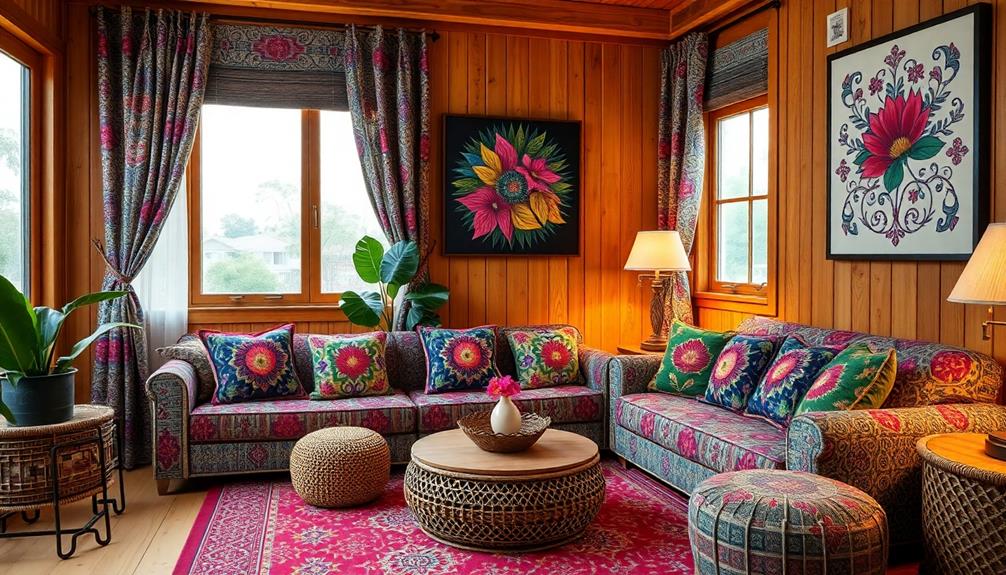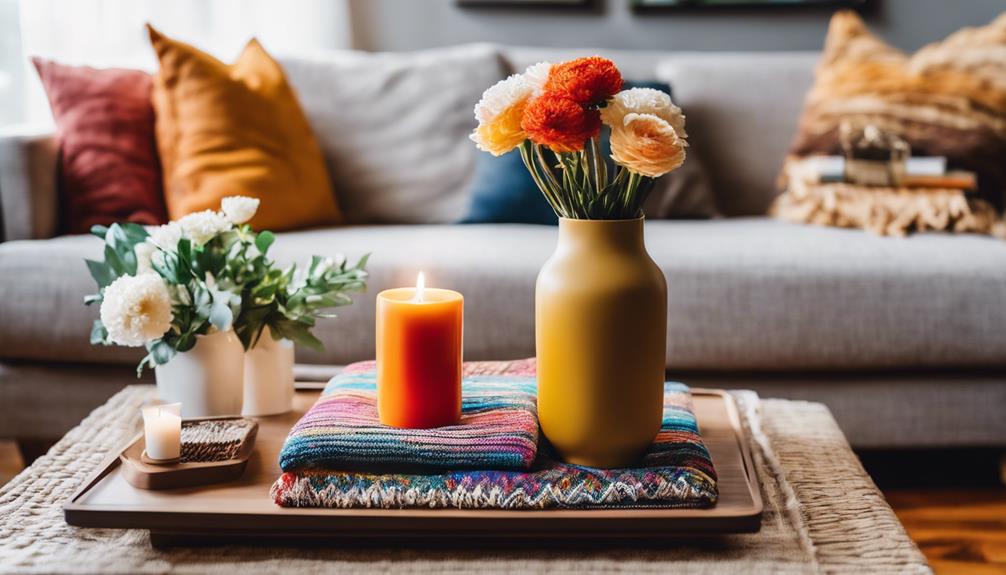Batik patterns weave a rich cultural narrative into your home decor. Originating from Southeast Asia, these vibrant textiles reflect thousands of years of heritage and artistry. With unique motifs symbolizing unity and strength, they enhance any space, offering a touch of tradition. You can incorporate batik into cushion covers, rugs, or framed art, creating an inviting atmosphere. Plus, every piece supports local artisans, fostering community and sustainability. By embracing these textiles, you'll not only beautify your home but also celebrate a timeless craft that tells a story. Discovering more about batik will reveal even deeper connections to culture and artistry.
Key Takeaways
- Batik patterns add vibrant colors and unique designs to home decor, creating inviting atmospheres that celebrate cultural heritage.
- Each batik motif carries a story, enhancing the aesthetic appeal by connecting spaces to historical narratives and cultural identity.
- Incorporating batik textiles in items like cushions and table runners enriches interior design with traditional craftsmanship and artistry.
- Supporting batik artisans promotes ethical consumerism and helps preserve traditional textile techniques for future generations.
- The blend of traditional batik with contemporary design creates a harmonious balance, appealing to modern tastes while honoring cultural roots.
History and Significance of Batik

Batik, a traditional wax-resist dyeing technique, boasts a history that spans thousands of years, primarily rooted in Southeast Asian cultures like Indonesia. This unique craftsmanship represents a crucial aspect of cultural heritage, with each region showcasing distinct styles and intricate patterns.
These designs often tell stories, reflecting local histories and social narratives, connecting you to the community's past. Additionally, similar to the unique artistic expressions found in Indonesian decor masks, batik embodies a rich cultural significance that enhances the appreciation for traditional craftsmanship.
The significance of batik extends beyond mere aesthetics; UNESCO recognized it as a Masterpiece of the Oral and Intangible Heritage of Humanity. Such acknowledgment highlights the need for preservation and appreciation of this art form.
As you explore batik, you'll discover that its patterns often symbolize social status, historical events, or spiritual beliefs, serving as a visual language that binds generations together.
For artisans, the craft of batik isn't just a skill but a lifeline, passed down through generations and allowing them to maintain their cultural identity while supporting their families economically.
Craftsmanship Behind Batik Creation
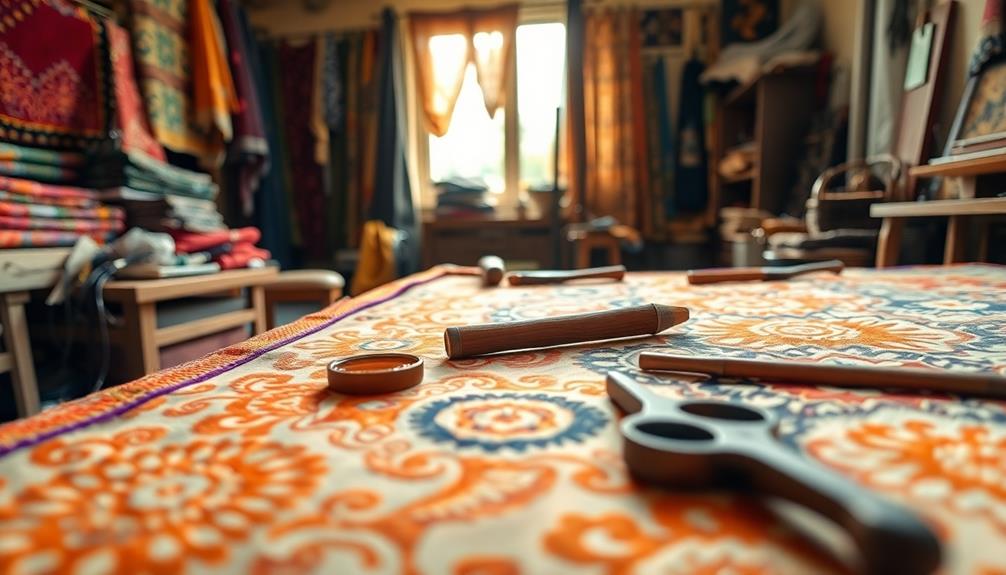
Creating stunning batik requires a meticulous process that showcases the artisan's skill and creativity. The journey begins with a plain cotton or silk fabric, serving as a blank canvas for intricate designs that tell cultural narratives.
Skilled artisans employ traditional tools, like the tjanting or stamps, for applying hot wax, which is essential in crafting Indonesian decorative pillows that enhance living spaces. This technique prevents dye from penetrating specific areas, allowing for the creation of stunning batik patterns.
The dyeing technique involves multiple layers of wax and dye baths, enhancing color depth and complexity in the final textile. Each dip in the dye brings the fabric closer to its final form, disclosing the vibrant hues that characterize traditional textiles.
After dyeing, artisans remove the wax through boiling or washing, revealing the intricate designs that make each piece unique.
The craftsmanship behind batik creation not only reflects the artistry involved but also honors the cultural significance of this timeless craft. Each batik tells a story, celebrating the connection between artisans and communities.
With every piece being handcrafted, you're guaranteed a unique textile that stands apart, embodying the rich heritage of batik artistry.
Batik Patterns in Home Decor
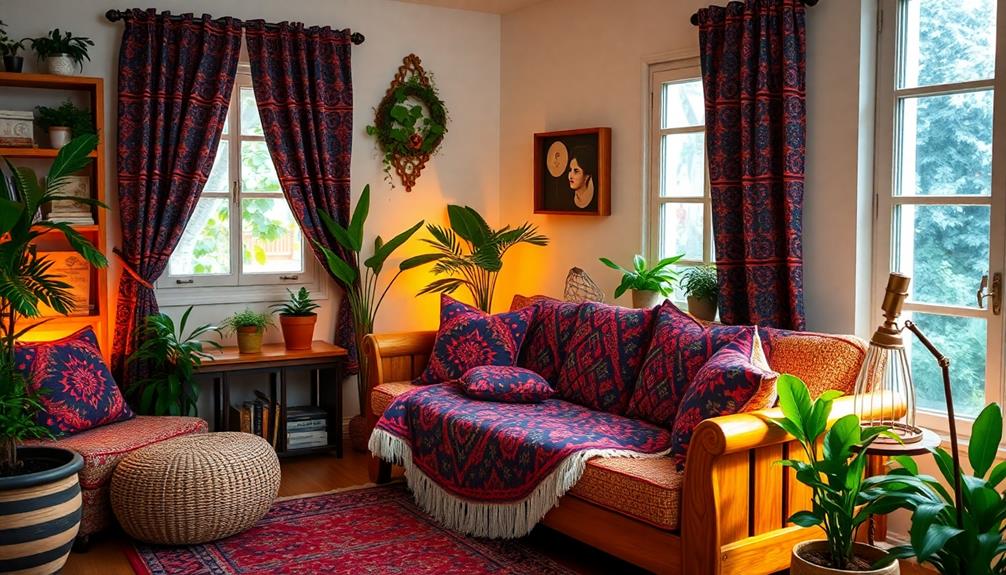
Incorporating batik patterns into home decor instantly transforms your space with vibrant colors and rich cultural narratives. These intricate designs, born from a wax-resist dyeing technique, can be integrated into various items, adding a unique cultural touch to your home.
| Item Type | Description | Benefits |
|---|---|---|
| Cushion Covers | Bright patterns enhance seating | Adds comfort and style |
| Tablecloths | Traditional motifs bring life | Perfect for gatherings |
| Curtains | Flowing designs create ambiance | Control light and privacy |
| Framed Fabric Art | Striking wall displays | Showcases craftsmanship |
| Batik Rugs | Warmth and texture in living areas | Invites coziness and charm |
Each piece not only elevates your aesthetic but also connects you to the rich storytelling embedded in batik designs. By choosing batik, you support local artisans and sustainable practices, making every addition a meaningful part of your home decor. Whether it's batik pillows or elegant draperies, these artistic expressions breathe life into your space, inviting a sense of heritage and authenticity.
Cultural and Economic Impact
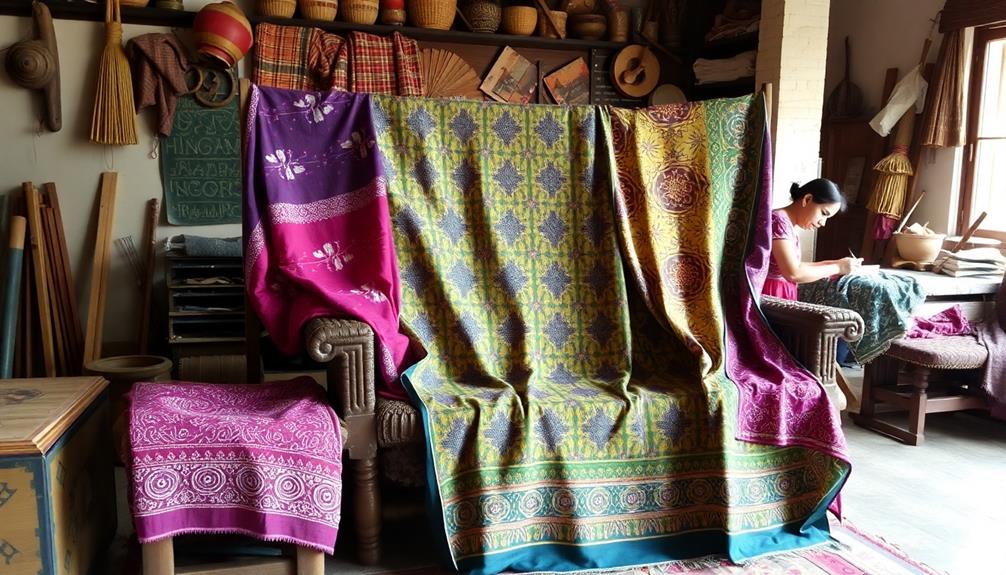
When you choose batik patterns for your home, you're not just adding beauty; you're also supporting local artisans and their communities.
These intricate designs often reflect traditional artistry that tells stories of rich cultural heritage, much like Indonesian decor masks.
Your purchase helps preserve cultural heritage and guarantees that traditional techniques remain alive for future generations.
Supporting Local Artisans
Supporting local artisans through the purchase of batik textiles not only empowers these skilled craftsmen economically but also plays an important role in preserving their rich cultural heritage. When you choose batik, you're directly supporting the traditional craftsmanship that has been passed down through generations. This choice fosters appreciation for the artistry behind each piece and helps sustain local economies.
Additionally, similar to how Indonesian decor masks represent cultural significance, batik textiles convey local narratives that enrich the decor of your home. Engaging in ethical consumerism means you're promoting sustainable practices in textile production. By opting for batik, you guarantee that artisans can thrive in a modern marketplace while minimizing environmental impact.
Organizations focused on batik preservation offer training and showcasing opportunities, creating pathways for economic empowerment. As the batik industry grows, it contributes to community development. Local artisans gain increased visibility and opportunities to share their cultural narratives through their work, enriching the cultural fabric of society.
Your support for these artisans doesn't just benefit them; it strengthens entire communities and helps keep their heritage alive. So, when you decorate your home with batik textiles, you're playing an important role in this vibrant ecosystem of tradition and economic growth.
Preserving Cultural Heritage
Batik textiles play an essential role in preserving cultural heritage while also driving economic sustainability in local communities. When you choose batik designs for your home decor, you're not just enhancing your living space with vibrant aesthetics; you're also supporting local artisans who rely on the global demand for their products. This demand helps sustain the local textile economy and showcases traditional craftsmanship that has been passed down through generations, much like the traditional Indonesian housing that reflects social status and regional identity.
By integrating batik into your decor, you celebrate the rich cultural influences and artistic diversity that these textiles embody. Ethical consumerism encourages you to make informed choices, ensuring that your purchases respect both the environment and the cultural heritage of the artisans.
Organizations dedicated to preserving batik culture play an important role in this process, offering training and opportunities that help maintain traditional techniques and designs for future generations.
In this way, your choices contribute to a sustainable cycle that preserves cultural heritage while enriching communities. By embracing batik, you become an advocate for supporting local artisans and safeguarding the artistry that defines their craft, ensuring that these beautiful traditions continue to flourish.
Embracing Comfort and Culture
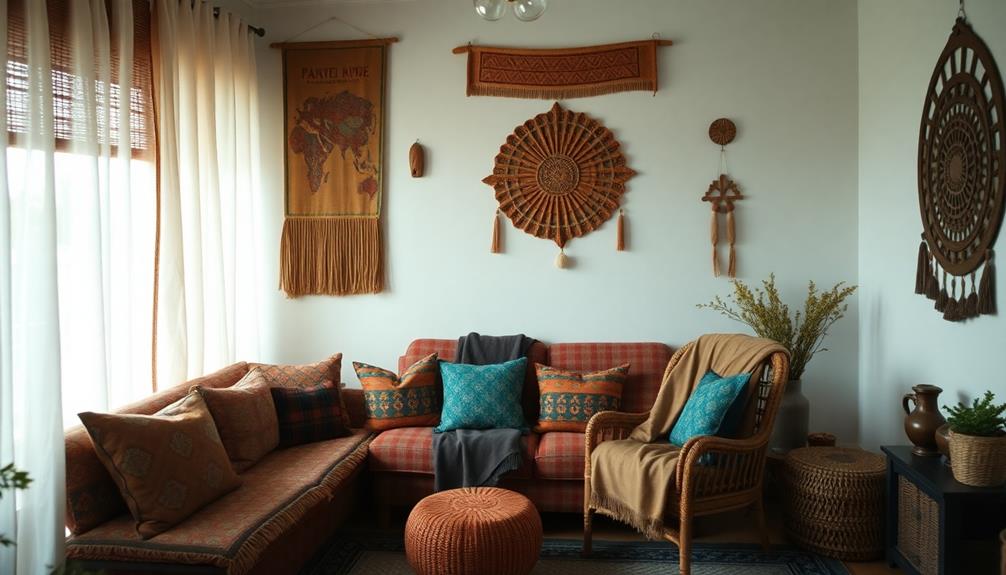
Incorporating handcrafted batik textiles into your home isn't just about aesthetics; it's a way to embrace cultural storytelling. Each piece carries a narrative that enhances your space while providing a unique ambiance.
By choosing these vibrant designs, you not only uplift your decor but also connect with the artistry and heritage behind them. Consider using traditional batik patterns for table linens and backdrops to further enrich your home with cultural significance.
This thoughtful integration of decor elements can create a warm and inviting atmosphere that celebrates Indonesian craftsmanship.
Handcrafted Textile Significance
Handcrafted batik textiles offer more than just aesthetic appeal; they weave together comfort and culture in a way that enriches your living space.
These batik fabrics showcase intricate designs that reflect the artistic heritage and cultural narratives of the artisans who create them, often incorporating traditional motifs that enhance the overall decor. Each piece is unique, a symbol of the meticulous craftsmanship involved in applying hot wax before dyeing, ensuring no two pieces are alike.
By incorporating these vibrant patterns into your home decor, you not only elevate the ambiance but also embrace the stories they tell.
The soft textures of batik textiles provide warmth and comfort, making them perfect for accent pillows and wall hangings. Plus, the use of natural dyes promotes sustainable practices, aligning with your eco-conscious values.
As you surround yourself with handcrafted batik items, you celebrate the beauty of art and heritage.
These textiles transform your home into a space that honors tradition while offering a cozy atmosphere.
When you choose batik, you're not just decorating; you're connecting with a rich cultural legacy that enhances your everyday life.
Cultural Storytelling Through Design
Art and storytelling intertwine beautifully in the world of batik patterns, where each design acts as a visual narrative that speaks to cultural identity and community heritage.
These batik motifs engage you in cultural storytelling, inviting you to explore the meanings behind intricate designs. By incorporating traditional patterns into your home decor, you foster a connection to heritage while enhancing the comfort of your living space.
Additionally, you can elevate your decor with unique pieces inspired by luxury tropical design aesthetics, creating a harmonious blend of culture and modernity.
Consider these elements when choosing batik for your home:
- Vibrant colors that uplift and energize your environment.
- Intricate designs that spark conversation and curiosity about their origins.
- Meaningful craftsmanship that honors the artisans behind each piece.
- Symbolic motifs like Sido Luhur and Pring Sedapur, reflecting honor, unity, and strength.
As you decorate, remember that each batik textile carries a story, transforming your home into a canvas of cultural expression.
Enhancing Aesthetic Ambiance
Batik textiles bring a unique charm to your home, effortlessly enhancing the aesthetic ambiance while embracing comfort and culture. By incorporating traditional batik into your interior design, you create a vibrant aesthetic that reflects rich cultural storytelling. Each piece showcases intricate patterns and designs, from floral imagery to geometric patterns, making them not just decorations, but works of art.
Consider complementing these textiles with luxury tropical designs that further enrich your space. Think about adding batik-inspired cushion covers or table linens to your living space. These textiles not only elevate the visual appeal of your home decor but also provide a tactile comfort that transforms the atmosphere. You can also utilize batik wall hangings or curtains; they can seamlessly blend traditional heritage with contemporary design elements.
The diverse motifs found in batik patterns evoke warmth and richness, inviting a sense of belonging and history into your life. With every choice, you weave a story that celebrates both comfort and culture, making your home a true reflection of your identity.
Characteristics of Batik Textiles
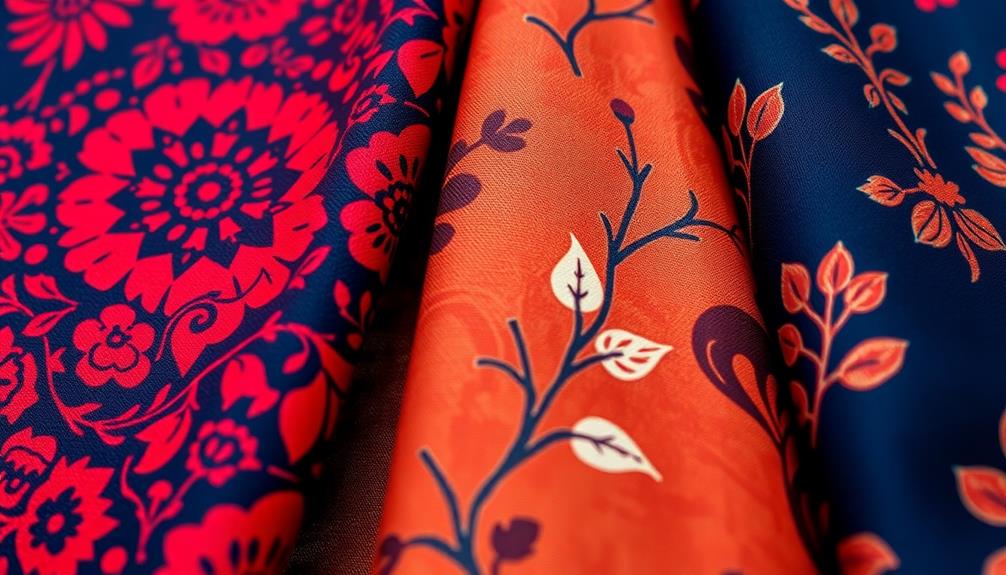
Immerse yourself in the world of batik textiles, where intricate patterns come to life through a traditional wax-resist dyeing technique. This process allows artisans to create stunning designs that reflect a rich history and cultural narratives, often seen in traditional Indonesian style home decor.
The beauty and ability of batik lie in its handcrafted nature, ensuring that each piece of fabric is unique.
Here are some defining characteristics of batik textiles:
- Natural materials: Typically made from cotton and silk, which provide a luxurious feel.
- Vibrant colors: Achieved through natural dyes from plants and minerals, resulting in a spectrum from earthy tones to vivid shades.
- Meaningful motifs: Designs often draw inspiration from nature and local culture, symbolizing unity, strength, and honor.
- Different forms: Batik can be found in various applications, from wall hangings to cushions, enhancing your home decor.
Whether you're looking for something elegant or bold, batik textiles offer a unique touch that elevates any space.
Techniques of Batik Production

Explore the intricate techniques behind batik production, where artisans skillfully apply hot wax to fabric with a canting, creating detailed designs that resist dyeing.
The batik process involves two primary techniques: Batik Tulis and Batik Cap. Batik Tulis is a hand-drawn method that's labor-intensive, allowing for unique, intricate patterns. In contrast, Batik Cap employs copper stamps, enabling quicker replication of designs while still maintaining quality.
During traditional batik-making, artisans often repeat the application of hot wax and dyeing multiple times. This repetition enhances the depth and complexity of colors, resulting in vibrant textiles. Natural dyes derived from plants and minerals contribute to a rich palette, ranging from earthy tones to striking shades, perfect for your home decor.
Once the dyeing is complete, the final steps in the batik process involve boiling the fabric, where the wax is removed. This vital stage reveals the intricate geometric designs, transforming plain cloth into a unique textile art piece.
Symbolism of Batik Motifs
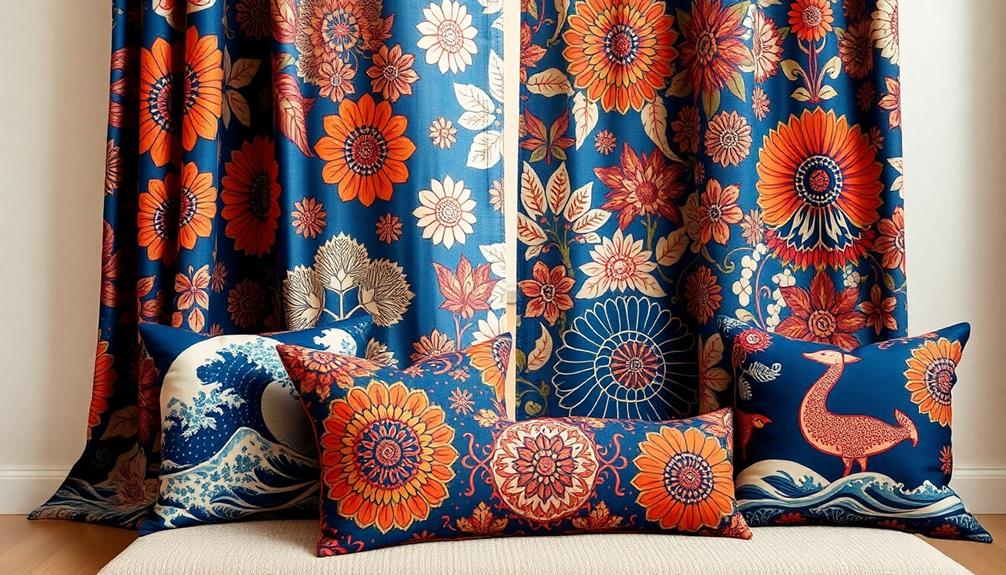
The vibrant patterns found in batik textiles are more than just visually appealing; they hold deep cultural significance that reflects the values and beliefs of the communities that create them.
Each batik motif tells a story, connecting you to the heritage and identity of the artisans.
Many designs draw inspiration from nature, incorporating elements that symbolize harmony and strength.
Consider these fascinating aspects of batik motifs:
- Sido Luhur: Represents prosperity and growth.
- Pring Sedapur: Symbolizes harmony with the environment.
- Lion Barong motif: Stands for protection and strength in daily life.
- Intricate designs: Often reserved for royalty or ceremonial use, showcasing social class distinctions.
These motifs also weave tales of local culture, with symbols that reflect both personal and communal values.
Whether you choose a pattern inspired by flora and fauna or one that embodies spiritual beliefs, you're not just decorating your space; you're preserving and celebrating a rich cultural narrative.
Embracing these batik motifs in your home decor allows you to honor the stories and traditions that enrich our lives.
Contemporary Uses of Batik
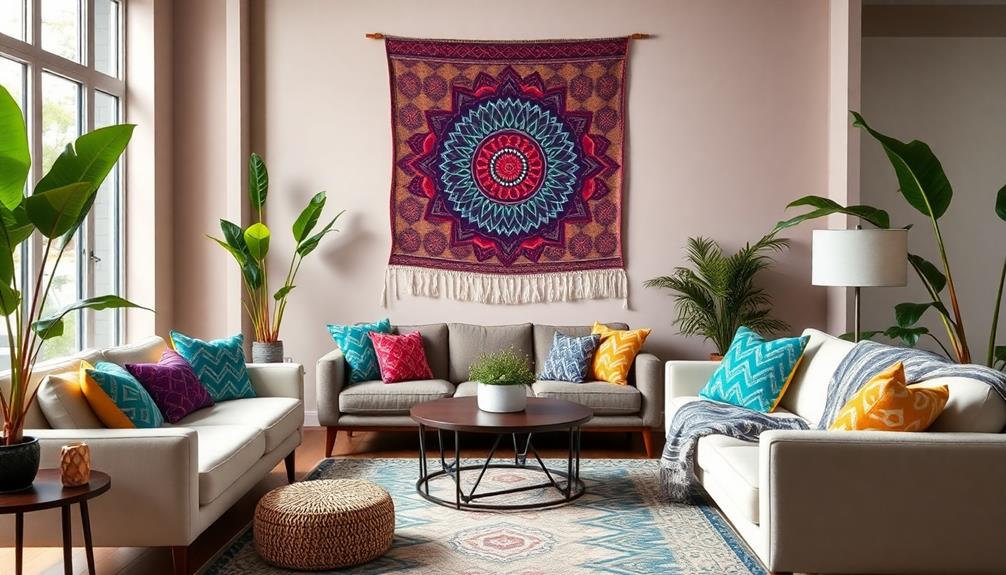
Batik's rich cultural heritage is making waves in contemporary home decor, bridging traditional artistry with modern design. You'll find batik popping up in various home accents, from throw pillows and quilts to table runners, showcasing its intricate designs and vibrant colors.
This trend allows you to blend traditional craftsmanship with modern aesthetics, creating unique decor that reflects your personal style. Designers are increasingly incorporating batik into upholstery, crafting statement pieces that not only highlight cultural heritage but also elevate your overall decor.
The adaptability of batik is impressive, as it fits seamlessly into diverse settings—think large wall hangings or smaller decorative accents that enhance both residential and commercial spaces.
As interest grows in sustainable and handcrafted textiles, batik's popularity rises, too. Consumers like you're enthusiastic to seek out authentic pieces that tell a story and support local artisans.
Frequently Asked Questions
How Can I Care for Batik Fabrics in My Home?
To care for your batik fabrics, you should wash them gently in cold water with mild detergent, avoid direct sunlight to prevent fading, and iron them on low heat to maintain their vibrant patterns.
Where Can I Purchase Authentic Batik Home Decor Items?
Sure, you could search high and low in thrift stores, but why not try online marketplaces or specialty shops? You'll find authentic batik decor that'll make your home look like a tropical paradise—without the airfare!
Are There Specific Color Meanings in Batik Patterns?
Yes, batik patterns often carry specific color meanings. For instance, red symbolizes courage, while blue represents calmness. Understanding these meanings can enhance your appreciation of the art and help you choose pieces that resonate with you.
Can Batik Be Used in Outdoor Decor Settings?
Imagine your outdoor space blooming with vibrant batik textiles. You can use them for cushions, table covers, or wall hangings, adding a splash of color and cultural flair that'll transform any patio into a stunning retreat.
How Do I Incorporate Batik Into a Minimalist Design?
To incorporate batik into your minimalist design, choose one or two statement pieces. Opt for subtle patterns in neutral colors, and balance them with clean lines and open spaces to maintain that serene, uncluttered feel.
Conclusion
Incorporating batik patterns into your home decor is like weaving a rich tapestry of culture and comfort. Each piece tells a story, connecting you to centuries of tradition and artistry. By embracing these vibrant textiles, you not only enhance your living space but also honor the craftsmanship behind them. So, let your home reflect the beauty and significance of batik, creating a harmonious blend of style and heritage that welcomes warmth and creativity into your life.
